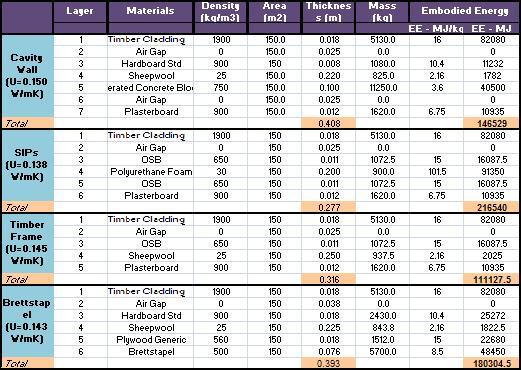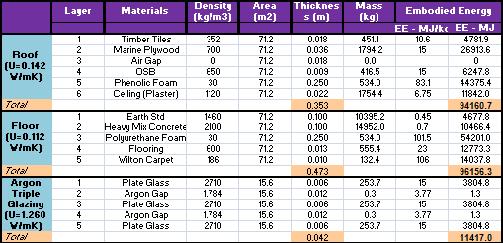
Project Overview
Construction
Occupancy
Behavioural models
Demand
Renewable technologies
Conclusion
Team
Acknowledgements
Construction
Embodied energy
First of all, it should be explained that there are two different kinds of embodied energy that a study may take into account:
- Initial Embodied Energy: non-renewable energy consumed in the acquisition of raw materials, their processing, manufacturing, transportation to site, and construction.
- Recurring Embodied Energy: non-renewable energy consumed to maintain, repair, restore, refurbish or replace materials, components or systems during the life of the building.
In our project, we will just focus in the Initial Embodied Energy due to the fact that we cannot predict how often the cabin will be refurbished.
In our purpose of selecting the best construction material we also have to have a look to the embodied energy consumed for each construction. Generally, we have seen that there is not a big difference in the total space heating needed for each construction since they were created in order to reach a U-value lower than 0.15 W/K m2 and hence the embodied energy will become very important when selecting the best construction option to make our community zero or low carbon.
The first thing to do is to calculate how much material of each type is needed to build the house. The procedure will be to find the area of material needed and to multiply it times the thickness of the layer of the correspondent material. Once we know the volume for each layer is easy to find out its weight just multiplying time the density of the material. After that we just need to take into account the embodied energy of each material in MJ/kg to assess the total embodied energy required to build each construction.
The following tables summarize the results obtained:
Table 1. Embodied Energy for wall constructions.

As we can see, the best option in terms of EE will be to use the timber frame construction. SIPs will be the worst option because of the use of polyurethane foam, which has an extremely high EE. Brettstapel and cavity wall construction have also higher EE due to the use of brettstapel and concrete block respectively.
Table 2. Embodied Energy for roof, floor and windows

Note that the values used for the embodied energy were taken from the Inventory of Carbon and Energy Database (ICE) Version 2.0 created by the University of Bath and they were doubled checked in some websites that you can find in the references section.
It is important to highlight that is very difficult to know the exact embodied energy of each material due to factors as variations in the consumption of total energy to manufacture the same product and variations in the fuel mix. Moreover, from all the major building materials timber presents the most difficulties due to reasons as the lack of high quality and detailed studies on timber within the UK and EU, and the fact that the UK consumes very few timber from the USA, who have a highest quality studies (CORRIM) which hence cannot be used in this case because timber properties are slightly different; for instance, the variations in the moisture content of the trees.
